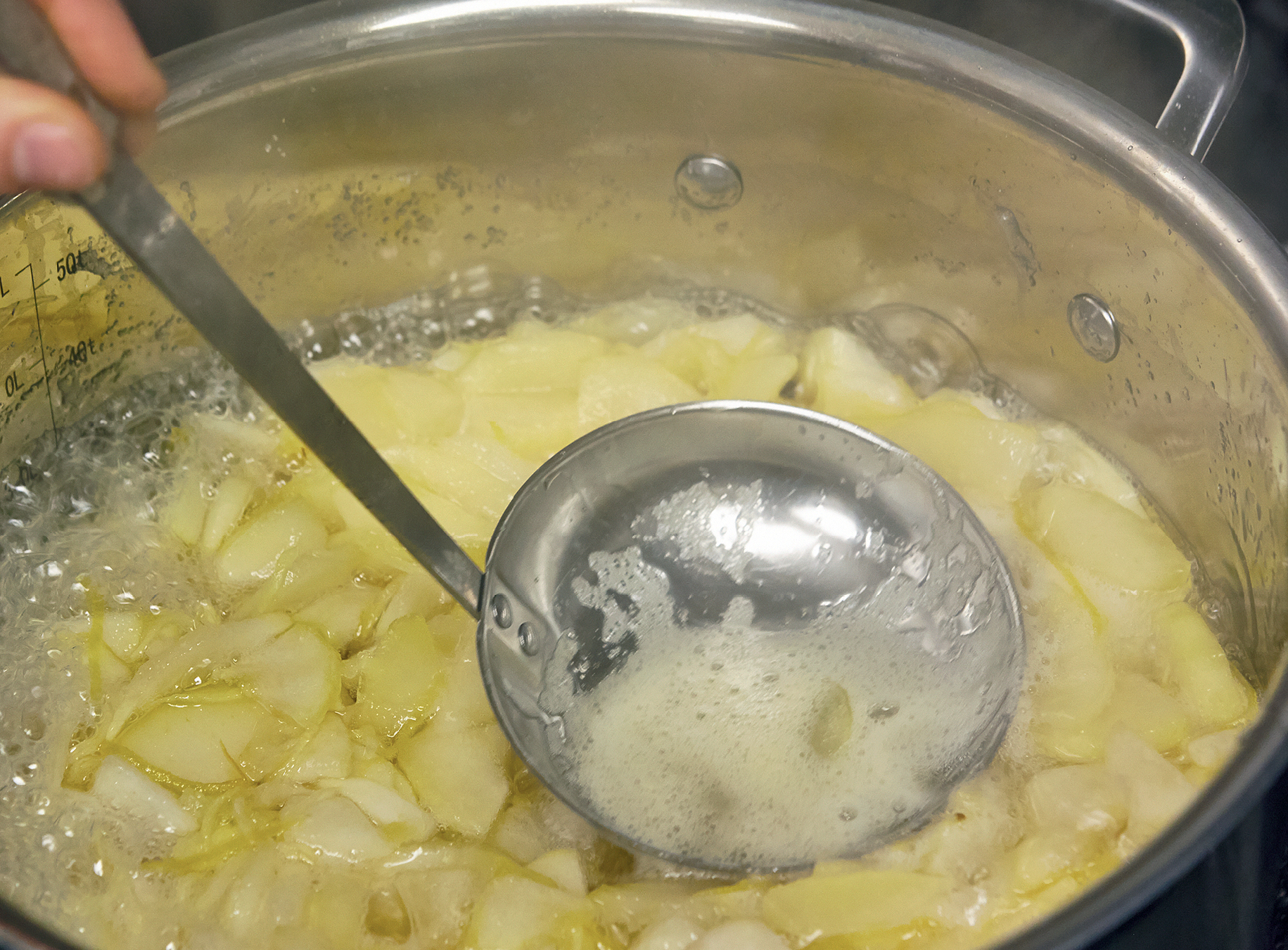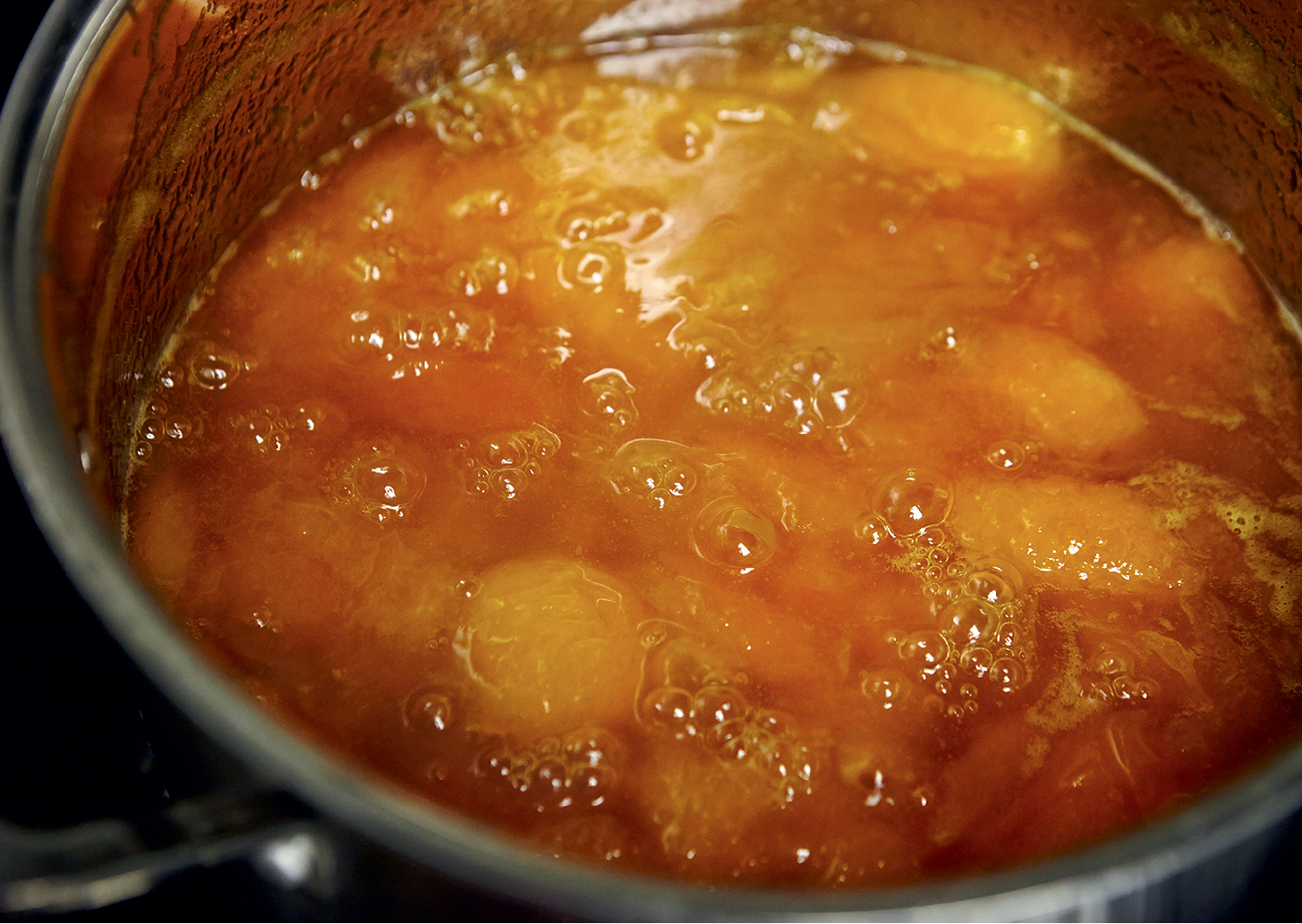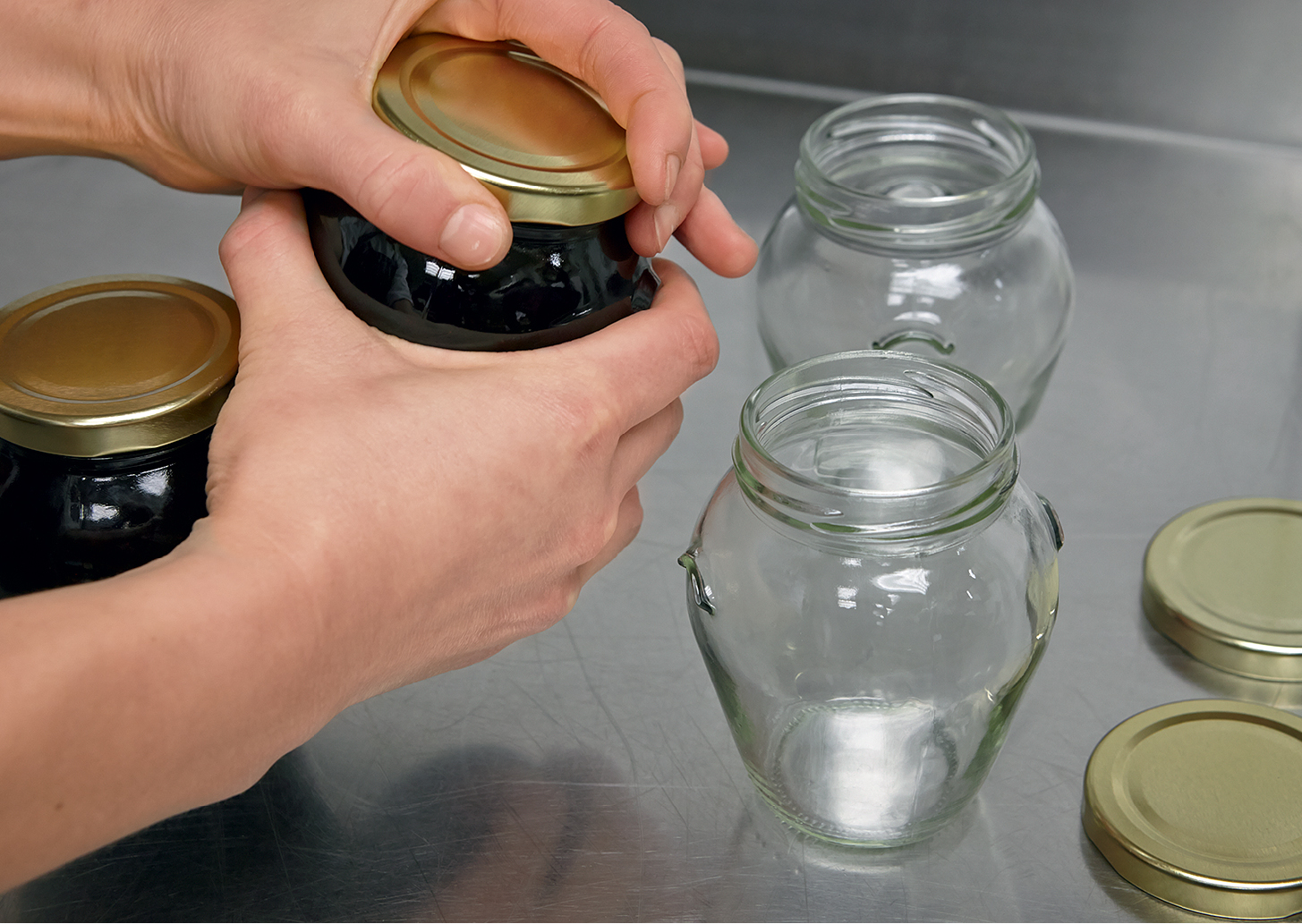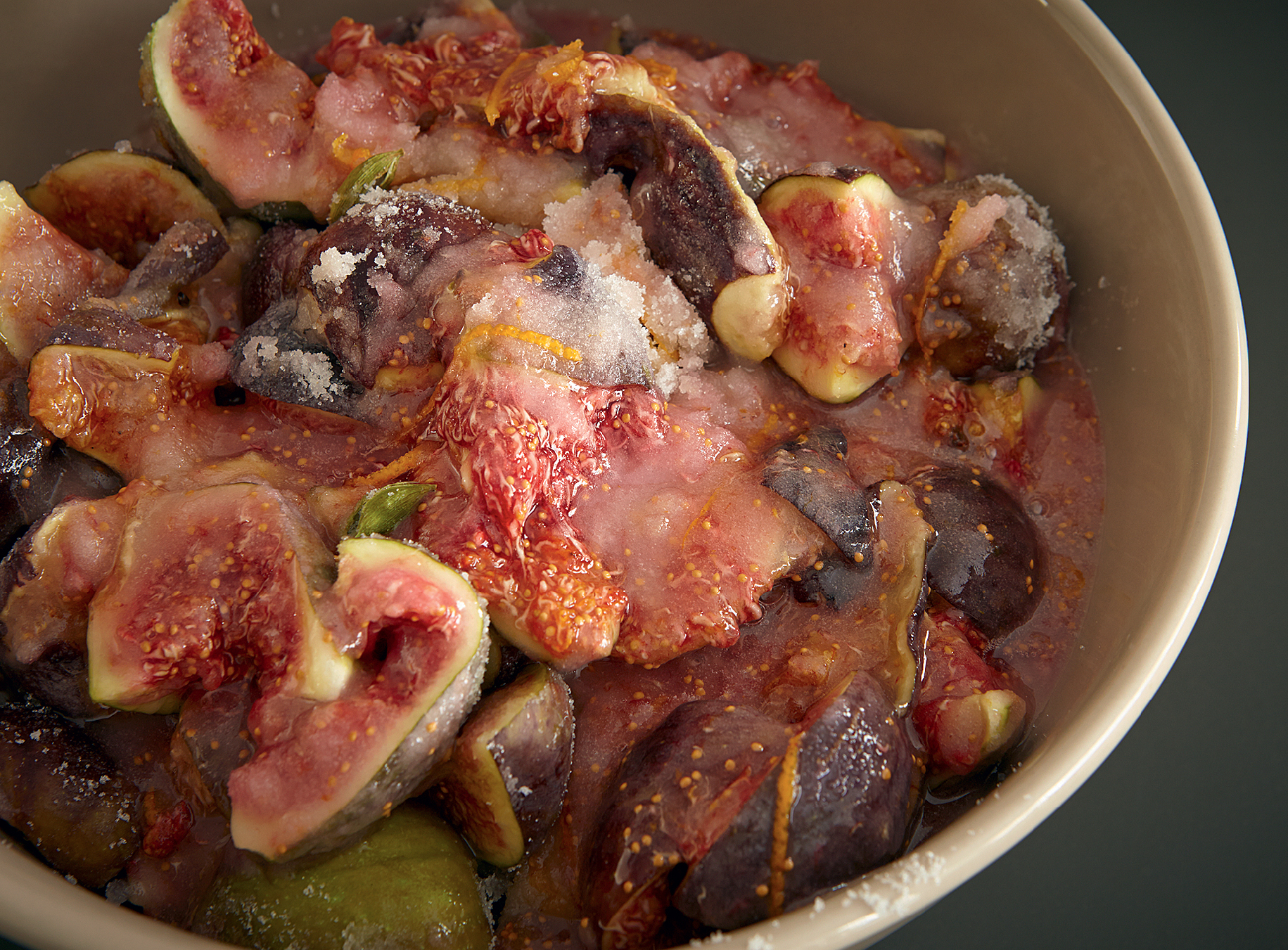Black fig, cardamom & orange jam
Makes about 2.5kg or 6–7 small jars
Takes about 45 minutes
2kg black figs
1.35kg granulated sugar
1 whole orange
1 vanilla pod (or 2 de-seeded pods, if you have used the seeds for other recipes like the one here)
8 cardamom pods
For the best results use ripe soft figs. If you use dry thick-skinned ones you will end up with a leathery jam. Remove the tip of each fig and cut into quarters (if they are really soft you can just tear them in half). Place the figs in a large jam pan and add the sugar. Use a peeler to create wide strips of orange peel, then halve the orange and juice it. Put the strips and juice in the pan. Slit the vanilla pod in half and add as well. Finally, crack open the cardamom pods and place the cracked pods in the pan. Mix everything together to moisten—I get my hands in there and squash the fruit (use disposable gloves if you have them).
Now set on a very high heat and bring to the boil. Make sure to stir quite often until the first bubbles start to appear—there is a real chance of it burning at this early stage since this is a heavy fruit that takes a while to produce liquid. Once the first bubbles appear, remove the initial foam, and reduce the temperature until the jam is at a medium boil. Make sure to stir on a regular basis so the jam doesn’t burn and continue skimming the foam that accumulates on top. This jam really doesn’t take long to cook when using ripe figs: 30–40 minutes will achieve a thick gloopy texture with a deep colored syrup and pieces of fruit still visible… and that is exactly the way I like it. Check the jam and when it’s ready, transfer to sterilized jars (see notes here).
Pear & ginger jam
Makes about 1.4kg or 4 small jars
Takes about 50 minutes
This is a very soft-set jam that has lovely pieces of fruit and slivers of ginger and lemon suspended in thick syrup. It is Itamar’s favorite from his days at Orna and Ella in Tel Aviv, and I make it especially for him.
2kg (about 12) whole pears, peeled and cored (1.6kg)
3 lemons
80g fresh ginger, peeled (about 60g)
800g granulated sugar
Cut the peeled pears into thin slices and place in a large jam pan. Use a strip zester to create lovely long threads of lemon peel or peel the lemons with a vegetable peeler and slice the peel into thin strips. Juice the lemons and add the zest and juice to the pears. Chop the peeled ginger into thin matchsticks and add to the pan. Finally add the sugar and stir to combine.
Place the pan on a high heat. Allow the mixture to come to the boil and skim the foam that accumulates on the top. Cook for 10 minutes on high before reducing the heat to medium, then continue cooking for 30 minutes, stirring occasionally. Check that the pear pieces are soft, then reduce the heat to the minimum setting and cook for a final 10 minutes. Transfer the jam to sterilized jars (see notes here), seal and allow to rest for at least a day before opening.

Apricot & elderflower jam
Makes about 2.4kg or 6–7 small jars
Takes about 40 minutes
We love making this as a very chunky jam with large pieces so we just halve the apricots, but if you prefer a less chunky version you can dice them and reduce the cooking time by 10 minutes.
1.8kg apricots, halved and pitted
1kg granulated sugar
For the elderflower
300g/ml elderflower cordial
juice of 1 lemon
or (in season) use
6 elderflower blossoms
150g granulated sugar
zest and juice of 2 lemons
Place the apricot halves in a large jam pan and cover with cold water, then drain, leaving the apricots in the pan. This washes the apricots and adds a touch of moisture, which helps the jam along. Cover with the sugar, then add the elderflower cordial and lemon juice or (if you are making this in season) add the blossoms, additional sugar and lemon juice and zest. Mix everything really well to moisten the fruit.
Set the pan on a medium heat to start dissolving the sugar and cooking the fruit. Stir occasionally and bring to a slow boil, skimming as you go. This is a very quick jam and will only take about 30 minutes from boiling to cook down, but make sure to stir regularly as it can burn easily. I keep it on the medium heat for the duration and only check it once the bubbles change in consistency and become big, thick and gloopy. I go for a very soft texture but if you want a thicker jelly-like consistency, reduce the heat to low and cook for a further 20–30 minutes until really thick. Once it is the consistency you want, transfer to sterilized jars (see notes here).

Quince jam
Makes about 1.5kg or 4 small jars
Takes about 1½ hours
1kg (about 3–4) quince, peeled and cored (750g), keeping hold of the peel and cores
1 lemon
1 liter water
500g granulated sugar
1 cinnamon stick (if you like, it’s delicious with or without)
Wrap the quince peel and cores in some cheesecloth or in an infusion bag and tie to seal. Chop the peeled quince into a chunky dice and place in a large jam pan. Halve and squeeze the lemon over, then add the squeezed lemon halves to the pan as well. Place the bag of peels and cores in with the quince dice, lemon juice and lemon skins and cover with the water. Set the pan on a high heat to bring to the boil. Skim away any foam that comes to the top and keep at a steady boil on a medium heat for about 30 minutes, or until the quince is soft when you pierce it with the tip of a knife.
Now remove the pan from the stove and, using a large slotted spoon or tongs, carefully remove the bag of peel and cores and the skins of lemon. Squeeze them into the pan to release any excess liquid, then discard. Add the sugar to the quince mixture and stir to dissolve it. The fruit should still be covered with liquid (if too much has evaporated, add a little water to just cover the fruit). If you wish to add the cinnamon stick, do so now. Return the pan to a medium heat to cook for another 30 minutes at a steady simmer.
Remove from the heat and use a stick blender or a potato ricer to mash up about half the fruit to a rough purée, and keep the rest in nice dice. Return to the heat and continue cooking for a further 30 minutes before transferring to sterilized jars (see notes here). The jam should be a dark orange by now and will set solid when cold.

Blueberry & apple jam
Makes about 1.5kg or 4–5 small jars
Takes about 50 minutes
600g apples (about 4–5 apples, ideally sour ones like Granny Smiths)
zest and juice of 2 lemons
1kg blueberries
700g granulated sugar
Peel the apples and remove the cores. Chop into small dice (about twice the size of a blueberry), tip into a bowl and douse with the lemon juice, then add the zest. Put the blueberries and sugar in a large jam pan and top with the diced apple.
Set on a high heat and allow to cook for 5 minutes. This should blast heat into the blueberries and explode them. Use a large wooden spoon to mix everything together to combine. Allow the mixture to come to the boil and then skim the foam that accumulates on the top. Continue to cook on high for 10 minutes, then reduce the heat to medium-low and cook for 20 minutes, stirring occasionally.
Check that the apple pieces are soft. By now the mixture should be nice and thick with a strong purple color. Reduce the heat to as low as you can and cook for another 10 minutes. That should be sufficient, but if you test it and it seems runny, cook for a further 10 minutes. Transfer the jam to sterilized jars (see notes here) and allow to rest for at least a day before opening. This will allow the pectin to set so you should get a firm jelly-like consistency around the pieces of fruit.

Citrus jams
Citrus jams are a personal favorite, and have always been a staple in our household. Whenever we go on holiday my thrifty wife empties the fridge and kitchen cupboards so that no fresh food goes to waste. This has brought about some amazing discoveries, like soba noodle and pea omelet (has to be tasted to be believed), and some less happy ones, like cabbage and rice casserole (memorable for all the wrong reasons). As we always have lemons and oranges in our fruit bowl, marmalade is a constant in her waste-not-want-not campaign, and the smell of citrus and sugar cooking is forever linked in my mind to the excitement before a trip—clothes and suitcases everywhere, last-minute phone calls and emails, the sudden panic of “where are the passports?” and a pan of marmalade bubbling in the background, a complete antithesis to the mayhem around.
These are our most successful attempts. Worth making even if you are not planning on going anywhere.
Orange, thyme & cardamom marmalade
Makes about 1kg or 3 small jars
Takes about 1¼ hours
3 large oranges (about 750g)
1 liter water
4 cardamom pods, split in half
4 sprigs of thyme, picked (1 tsp picked leaves)
750g granulated sugar
Wash the oranges well with soapy water and rinse, or use organic unwaxed ones if you can find them. Remove the stem stump and halve the oranges. Remove the white pithy center and any seeds you can see, then slice as thinly as you can. Place in a medium-large pan and cover with the water.
Bring to a rapid boil, then skim well and add the split cardamom pods and the thyme leaves. Boil for 30 minutes, then start adding the sugar gradually, stirring after each addition to make sure it dissolves properly.
Bring back to the boil and skim again. Boil on a medium-high heat for another 30 minutes or so until the look of the bubbles changes and the jam looks thick and syrupy, then transfer to sterilized jars and seal while hot (see notes here).

